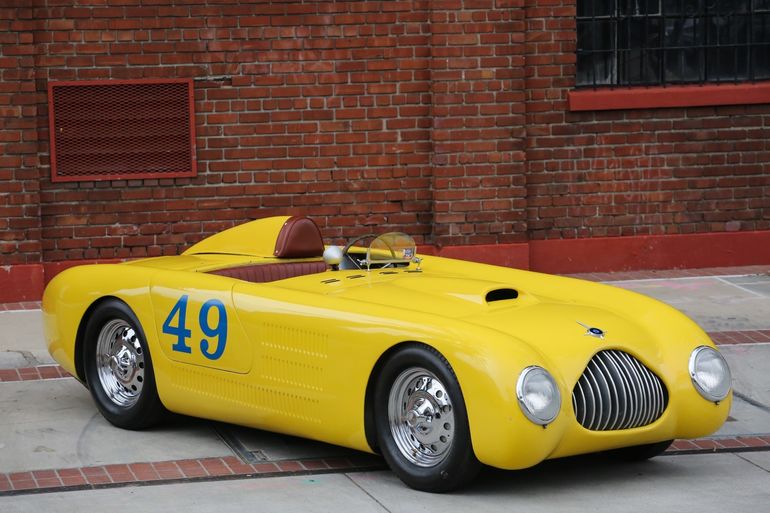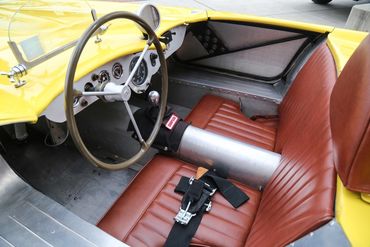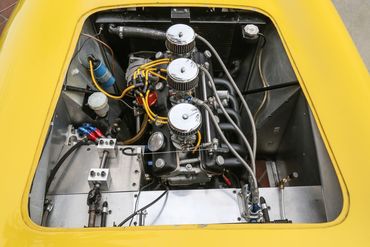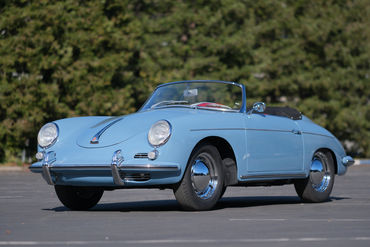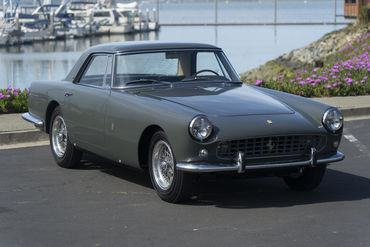Sold
SOLD 08/20
1947 Veritas
BMW Rennsportwagen
Rare and Highly Event Eligible BMW-Powered Veritas. Ideally Suited to Historic Racing or Road Rallies. Fascinating Early European Race History and Very Well Documented.
- VIN5036
- Exterior ColorYellow
- Interior ColorBrown
- MileageTMU
- EngineBMW 2 liter Inline 6 Cylinder
- TransmissionVolvo 4-Speed
- StatusSold
- StockFJ2345
Description
1947 Veritas Rennsportwagen
s/n 5036
Yellow with Brown Interior
Veritas rose up from the ashes of a post-war Germany nurtured by the hopes and ambition of three returning soldiers embattled from the last gasps of the second world war. As civilian life and entertainment slowly returned to Germany, spectators and former service men gathered along the fringes of the Autobahn to watch one of the first races held after the war. It was here that founding partners Ernst Loof (an ex-BMW engineer), Georg Meier, and Lorenz Dietrich, would see streamlined Touring bodied BMW race cars compete. Motivated by their mutual experiences, the three decided to form Veritas - a small European automotive performance development company. Their first efforts would focus primarily on rebuilding and tuning pre-war BMW 328 series cars. The team were no strangers to both aircraft and motorsports technology so even their early cars were rather sophisticated including race prepped engines, modified suspension, and lightweight aluminum bodies. Badged as “BMW-Veritas”, their first car was completed in 1947. Having met with surprising success at racetracks, the cars earned the attention of BMW who quickly insisted their names be removed from the cars. Veritas, so named from the Roman goddess of truth, would stand thereafter in unique distinction, but forever associated with the BMW componentry that served their development needs.
Historically, Veritas would become one of the pioneers of early independent sports and racing car manufacturing, utilizing specific larger manufacturer components while putting their own unique engineering performance twist on their cars. Having more than rudimentary experience in aircraft construction, their designs and build processes closely mimicked that of war planes from this era. Working on a tight budget and leveraging other larger builders for costly componentry, this process, while familiar to many small constructors through the late 50s and 60s, was innovative and pioneering for Veritas. Indeed for a small 1940s era independent company of largely newcomers they did remarkably well building their own cars. Veritas cars were built with pride, quality craftsmanship, and design excellence, resulting in some of the most striking, advanced, and competitive cars of the modern sportscar era.
In addition to their racecars, Veritas also built a range of road cars, beginning with the Komet Coupe, a modified Veritas RS made for street use, followed by the Saturn 2+2, and Scorpion Cabriolet, the latter two of which were designed by Ben Bowden (formerly of Rootes, Humber, and designer of the iconic Spacelander bicycle).
Driven by their passion and early success, the one thing Veritas knew would bring them further distinction was to design and develop their own engine. Extensive research and engineering as well as tooling and castings were developed, but this was a risky and costly move that would ultimately tap resources beyond their means. By 1949 orders for their specialized road cars were in great demand, but Veritas needed more funds to meet those demands. Eager to earn revenue they engaged in contracts as constructors for other companies as a means to finance their own projects. Sadly, in 1952, though customer interest was strong and output for such a small company was remarkable, after having built roughly 75 cars, the financially challenged Veritas was unable to secure the much-needed bank loans to bridge the gap. The Veritas factory was closed only a few years after making their considerable mark as a post war independent builder of sports cars. Of the 75 cars built, approximately 20-25 Rennsport models were completed, of which 15 examples are believed to survive today.
This particular Veritas RS (also referred to as Rennsport or Rennsportwagen), chassis number 5036, is a compelling story of survival, tragedy, and persistence. Just like the origin of the Veritas name, exemplifying truth, it would take decades to finally uncover the remarkable hidden history behind this specific car. Like all the Veritas RS models assembled at the factory, each car was uniquely built, each with individual character, unique hood scoops, distinct grilles, headlights, and hand stamped louvers – key and defining features that would later be critical to historic verification.
In 1948, Veritas RS chassis number 5036 was delivered from the factory to the first owner. In a series of articles and various representations on the history of the car, the first sale was initially attributed as having been part of a four-car package delivered to Belgian racecar driver and team owner of Ecurie Francorchamps and Ecurie Nationale Belge, Jacques Swaters. This assumption was the conclusion of former owner John Zilisch, who uncovered during his restoration, that the car had been previously painted yellow, and surmised it as having been part of the “Ecurie-Belge” heritage. Further supporting this assumption, were two contemporary 1949 magazine articles stating that the yellow car tested for their magazine use was equipped to run on alcohol and was also fitted with front wheel covers or “spats”. In addition to the evident yellow paint hidden under multiple layers of other colors, the other two features were also reported as part of #5036 when discovered and documented by Zilisch when he discovered the car.
Yet unknown to Zilisch and many others, however, was the truth behind #5036. Rather than having been a largely unknown participant car in a purchase package for Swaters, chassis #5036 would eventually be discovered to be one of the most highly campaigned and privately raced Veritas RS models in history, including 1948 and 1949 2nd place finishes at the famed Nurburgring and Hockenheim racetracks. In 2014, the current owner of #5036 commissioned a thorough and copiously noted 36 page document to refute any lasting speculation on the actual history of #5036. What follows herein is the translated summary of the German language document, portions of which are annotated here in summary form. These collective summaries and translations should be considered the most up to date representation of the car and its subject history. While additional information may be further forthcoming, it should be noted that the current compilation is derived from Veritas experts, with ample citations from Veritas books and period photographs, further supported by statements from previous owners, and backed by period photographic confirmation of critically unique details, specific to #5036.
The Early Years
1948 – 1950 First Owner: Adolph “Ralph” Roese
1951 – 1952 Second Owner: Joseph Peters
Ralph Roese began his successful career racing motorcycles. He would rapidly rise to become one of the most successful German private drivers, with his 750 BMW. In 1931 and again in 1932 he was the German Champion. From 1934 – 1938 Roese raced 2 Liter BMW 328s wining the 2 Liter class of the Grand Prix of Antwerp, and wining again in other classes. By 1940 he placed third in the Mille Miglia. After the war, Roese resumed racing in 1946 and, in 1948, acquired Veritas RS chassis #5036, which he would own and race until his tragic death en route to Veritas to purchase another racecar.
Ralph Roese races driving Veritas RS chassis #5036
May 9, 1948 Hockenheimring 2nd place
August 15, 1948 Schottenring 3rd place
September 5, 1948 Eggbergrennen 3rd place
May 8, 1949 Hockenheimring 2nd place
May 22, 1949 Eifelpokal/Nurburgring 2nd place
September 11, 1949 Grenzlandring 1st place
September 18, 1949 Saarbruken 2nd place
The extent of these racing accomplishments for any private driver at historic European racing venues is quite significant. These races stand on their own and yet they are only the beginning of the race history associated with #5036.
After the death of Ralph Roese, Joseph Peters is next known to have been in possession of #5036. Both Roese and Peters are seen driving #5036 as verified by the uniquely spaced louvers seen only on the original car in period photos, and later seen in the original bodywork photographed by later US owner John Zilisch. After the untimely death of Roese, Peters continued to race the car again at some of the premier race tracks in Germany.
Joseph Peters races and accolades driving Veritas RS chassis #5036
May 14, 1951 Hockenheimring 5th place
June 3, 1951 Nurburgring 5th lap DNF in 10th
August 5, 1951 Schauinsland 6th place
September 2, 1951 Norisring 2nd place
September 9, 1951 Grenzlandring 3rd place
August 3, 1952 Nurburgring 5th place
August 31, 1952 Grenzlandring 3rd place
September 28, 1952 Avus. 3rd lap DNF in 8th
1951 5th in the German Championship for sports cars up to 2 Liter
1952 8th in the German Championship for sports cars up to 2 Liter 1953 5th All Around Nurburgring 1000km, co-pilot Wolfgang Seidel
Veritas #5036 Arrives in America
Circa 1970 Ron Ewing First Known American Owner
1971 - 2007 John Zilisch Long Term Owner/Jim Profitt Restorer
2007 – 2019 Current ownership
After Joseph Peters’ ownership, #5036 enters into a period of currently unverifiable ownership or confirmed location. At some point, likely in the late 1950s, the car is imported to the US, most likely by a returning American serviceman, and based on the condition and modifications when found, very likely it was modified slightly to compete in US races through the 1960s. Embattled from racing but still complete, by 1970 the car becomes the property of Mr. Ron Ewing, Albuquerque, NM where the history continues with certainty and photographic documentation.
Ron Ewing, the first verifiable US owner of #5036 retains the car until 1971 when John Zilisch comes in contact with him via a chance meeting while visiting New Mexico. Zilisch, then working for Caterpillar in Arizona, visits the New Mexico facility and meets German mechanic John Seidel. The two men engage their mutual interests in racecars, particularly of German origin. Seidel, having been chided by the younger workers who had no knowledge of such things, finds the visiting Zilisch to be receptive to his conversations about BMW and Veritas, and confides to Zilisch about a Veritas languishing somewhere in the arid fields of New Mexico. The two men embark on a lengthy drive until Seidel locates the car. The car showed signs of having been raced in the US including wearing Firestone tires and a custom side pipe. Although the grille had been removed and the air opening widened and the hood scoop removed, the car was relatively complete, albeit poor condition, including the BMW engine, carburetors, wheels, while retaining a majority of the mechanical components.
Ron Ewing offers the car to Zilisch for $2,000.00. Zilisch, short on cash, takes photos of the car and departs. Over the course of the year, Zilisch returns to New Mexico multiple times, taking additional photos of the car. Some months later, Zilisch, able to secure the full $2,000.00 asking price, purchases the car. Zilisch borrows a trailer to pick up the car, but before departing, he captures several more critically important photos of the then largely original #5036, securing the visual documentation that would be critical to identification more than 40 years later.
During the course of his 36 year ownership, Zilisch engages the services of Jim Profitt for restoration. Profitt himself, an important figure in the preservation and restoration of BMW cars, is given significant liberties with the restoration of the car. By 1986 Zilisch publishes an article in the magazine “After Hours”. The article titled “1949 BMW Veritas Rennsport – a 25 Year Odyssey, the story of the discovery, identification, and restoration of the car” covers the history as understood by Zilisch at that time. In the article Zilisch makes that claim regarding layers of paint removed during restoration, the oldest of which is claimed to be yellow, leading to the first steps speculating the false connection of #5036 to the Ecurie Belge Veritas. Further supporting this claim, Zilisch is transferred to Malaga where he is able to reach the aging Jaques Swaters (a founder of Ecurie Belge) and the two men speculate as to the origin of the car. Swaters is unable to provide photos or documentation proving any chassis numbers or definitive indications supporting the claim, but the two men assume the yellow paint, front fender spat mounting holes, and alcohol fuel set up of both cars is more than coincidental. However, in later statements with driver and Ecurie Belge member Dennis Poore, he reports his car as having been racing green, a fact substantiated by the darker exposure in the period photo of the Belgian Veritas attributed to Poore.
Suffice it to say, both Zilisch and Profitt were operating under challenging documentation methods and poor record keeping. So it is fair to say that the assumptions based on their findings and honest speculation was fairly deduced. However, the resultant research, confirmation via photos and period reference materials concludes that #5036 was not a part of the Belgian team and in fact was the car raced and owned by Roese and Peters before arriving in the US in 1971. The known, documented ownership trail consists of Roese (1948-1950), Peters (1951-1952), Ewing (circa 1970-1971, perhaps as early as the late 1960s), Zilisch (1971-2007) and the current owner.
The Zilisch/Profitt Restoration – Saving #5036
Upon examining the car, Profitt went about removing all the layers of paint, but neglected to document any of the process with particular detail. Concurrent with the restoration, Profitt was also working on at least one other BMW Veritas and other BMW cars, so he had several cars to reference as part of his efforts. Profitt, at that time having rescued and retained the Hanstein/Baumer 1940 Mille Miglia winning BMW 328 from an otherwise certain demise, was well aware of the rarity and importance of these cars as well as the handmade nature of each Veritas.
Having discovered that much of the bodywork and a great deal of the subframe of #5036 had been too severely compromised by the elements to restore, it was determined that a new body substructure and aluminum body shell should be constructed to the original dimensions. Modern restoration processes 30+ years later would certainly have changed the decisions, but their preservation efforts saved as much of the car as possible. Like so many racecars of the early years, bodies were damaged and reformed, sections reconstructed, and major components switched out. In the case of #5306, the hood and doors appear to have been saved from the original construction, though the hood scoop has been remade. Photos showing the substructure for the body and interior panels were carefully formed following the original patterns used from the remaining original body. During the construction of the current body, the holes that had been previously located for the front wheel spats were not included. The varied dimensions of the 15th and 17th louver were not replicated, as well as the lower louver section (having been completed with uninterrupted continuity), leave out a key element in the original bodywork that confirms #5036 as the Roese/Peters car and further confirms it as the Ewing car before Zilisch’s purchase and subsequent restoration.
While great care was made to preserve the original frame and suspension components, a significant amount of time was spent to update the car in order to make it usable both as an event car and for historic racing. Prior to the current owner’s purchase, BMW and Veritas expert Jim Smith inspected the car reporting that the chassis was a 315/1, being very similar to the 328 series chassis only differing with mechanical brakes. Concluding from his inspection, the engine currently in place is an industrial block (likely not the original, but a stout and appropriate replacement), fitted with a BMW 328 BMW head built by Jim Profitt. Most likely the engine contains a 501 crankshaft with the larger mains and longer rods. The engine was outfitted with Weber carburetors. The foot pedals were slightly altered to improve legroom. The BMW transmission was replaced with a 4-speed Volvo unit, using a bell housing from Helmut Feirabend. The original Bosch starter was retained, while the generator was replaced with an alternator. An electric fuel pump was installed, oil pump, and electric fan. Updated safety systems include a fire system, electrical cut off, and a modern fuel cell.
Today the car presents in very good condition throughout, featuring quality finishes and appropriate upgrades to benefit the performance and driving experience. The striking yellow paint is very nicely finished with excellent gloss throughout the surfaces. The body construction was completed over a period of several years, concluding in or around 1996 when delivered to Zilisch. The car shows minor marks in various areas throughout the body surface, none of which take away from the overall visual impact. The chrome plated wheels are correct BMW type wheels using correct knock offs per the period. The car has a fantastic stance with a slight forward rake giving the car a wonderfully commanding profile.
Inside, the cockpit is minimally trimmed per the original design, suitably constructed for race duties. The Veritas VDO instruments are beautifully presented, mounted against the brushed aluminum dashboard. The cockpit conveys the utility and purposefulness of the car, from the thin aluminum doors, large steering wheel, and small windscreen, the machined simplicity of these cars is honestly revealed. Outfitted with a contemporary Simpson gearbox guard, vintage competition lap belts, and a fire suppression system, these important safety upgrades have been added with reverence to the original design.
Under the lift-off hood, the BMW engine resides with a blend of correct vintage components and appropriate upgrades as noted earlier. The BMW 328 head houses triple Weber carburetors with modern air cleaners, modern fuel lines and fittings, all tied together by hand formed aluminum inner panels making up the engine compartment cowl and inner fender structure. Under the rear access panel, a contemporary fuel cell has been installed, flanked by a Halon fire suppression bottle. The underside of the car reveals a combination of restored original components and remarkable body and inner panel construction which appear clean and tidy, exhibiting only minimal evidence of use.
Having been stored for some years and only minimally exercised, we recommend the next owner engage a qualified racing specialty shop to perform a careful review and inspection of all mechanical components of the car prior to spirited competition use.
With the remarkable period race history, recently discovered provenance, and commendable resurrection of a once victorious post war racecar, this Veritas RS boasts the original ownership of racing legend Ralph Roese and Joseph Peters, whom collectively achieved 1st place Grenzlandring, five 2nd place wins, and five 3rd place wins between 1948-1952 at many of the most famous German motorsports venues in history. The outstanding recorded history and success of Veritas RS #5036 secures it as an important and highly relevant racecar of the early post war era and certainly among the most successful Veritas racecars to have competed in Germany.
This Veritas is titled as a 1949 year model.
The above vehicle information is complete and accurate to the best of our knowledge at the time it is posted to this website. Corrections or additional information is always appreciated. All advertised prices exclude government fees and taxes, any finance charges, any dealer document preparation charge, and any emission testing charge. Vehicles are subject to prior sale. All advertised to be true but not guaranteed. We assume no liability for errors or omissions.
Inquire About This Car
Fantasy Junction • 510-653-7555 • 1145 Park Ave, Emeryville, CA 94608
